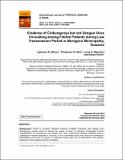| dc.contributor.author | Mboya, Lightness Benedict | |
| dc.contributor.author | Nkya, Elingarami S. | |
| dc.contributor.author | Matemba, Lucas E. | |
| dc.contributor.author | Kinim, Edson | |
| dc.date.accessioned | 2020-12-21T10:55:44Z | |
| dc.date.available | 2020-12-21T10:55:44Z | |
| dc.date.issued | 2020-02-26 | |
| dc.identifier.uri | https://doi.org/10.9734/ijtdh/2019/v40i430236 | |
| dc.identifier.uri | https://dspace.nm-aist.ac.tz/handle/20.500.12479/1067 | |
| dc.description | This research article published by International Journal of TROPICAL DISEASE & Health, 2020 | en_US |
| dc.description.abstract | Background: There is currently sufficient evidence available indicating that dengue and chikungunya viruses could be among the causes of fever in Tanzania. Overlapping clinical manifestations of chikungunya and dengue with other vector-borne parasitic diseases pose a challenge for medical diagnosis in Tanzania. A virus surveillance study was conducted in Morogoro Municipality which had no reports of outbreaks during high risk of transmission with dengue epidemics in the neighbouring Dar es Salaam.
Methodology: The present study was carried out to screen for dengue (DENV) and chikungunya (CHIKV) in sera from patients with fever and malaria-like symptoms on selected health centres in Morogoro municipality (n = 5) during March-May 2018. Three hundred and twelve febrile individuals presenting to the outpatient department were screened for the presence of chikungunya and dengue viruses using Multiplex real-time reverse transcription-polymerase chain reaction.
Results: Acute CHIKV infection was confirmed in four (1.28%) cases whereas no acute DENV infection was detected. Acute chikungunya cases were exclusively prevailing amongst female patients aged between 20 and 49 years.
Conclusion: Our findings indicate an active circulation of chikungunya virus among febrile patients seeking medical attention in Morogoro Municipality, Tanzania. The improvement of CHIKV case detection and reporting is critical to its control and prevention. Surveillance programmes in monitoring arboviral activities in human populations as well as in mosquitos should be performed to avoid maintenance of CHIKV in mosquitoes that may lead to future outbreaks. | en_US |
| dc.language.iso | en | en_US |
| dc.publisher | International Journal of TROPICAL DISEASE & Health | en_US |
| dc.subject | Chikungunya virus | en_US |
| dc.subject | Dengue virus | en_US |
| dc.title | Evidence of Chikungunya but not Dengue Virus Circulating among Febrile Patients during Low Transmission Period in Morogoro Municipality, Tanzania | en_US |
| dc.type | Article | en_US |

